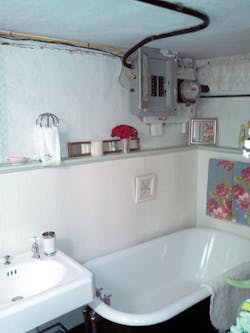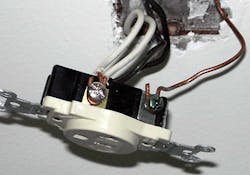How well do you know the Code? Think you can spot violations the original installer either ignored or couldn’t identify? Here’s your chance to moonlight as an electrical inspector and second-guess someone else’s work from the safety of your living room or office. Can you identify the Code violation(s) in this photo? Note: Submitted comments must include specific references from the 2011 NEC.
Hint: A close shave
'Tell Them What They've Won...'
Using the 2011 NEC, correctly identify the Code violation(s) in this month’s photo — in 200 words or less — and you could win a $50 gift check. E-mail your response, including your name and mailing address, to [email protected], and Russ will select three winners (excluding manufacturers and prior winners) at random from the correct submissions. Note that submissions without an address will not be eligible to win.
August Winners
Our three winners this month were: Michael R. Devens, a facilities electrician with NSTAR in Southborough/Worcester, Mass; Ken Hrabovecky, a manager with KM Transfer and Services, Inc., Hampton, N.J.; and Bill Williamson, a project manager with Power Engineers, Inc., Norcross, Ga. All three of them were able to correctly identify the Code violations at this receptacle location.
Shoving two wires under a screw terminal designed for only one wire is a great way to make a lousy connection. In fact, it creates a Code violation. The very last sentence in 110.14(A) tells us in a straightforward way that specially identified terminals are required for terminating more than one conductor. Nonetheless, when I pulled this receptacle out of the box, I discovered two white wires and two black wires mistakenly landed on terminals designed for only one wire. This would also be a violation of 110.3(B) since the installer ignored the instructions in the listing and labeling of this device. A better way to do this installation would have been to make a 3-wire splice for each circuit conductor and then connect the “pigtail” wire from each splice to the correct terminal on the receptacle. Ironically, this was how the equipment ground wire was correctly terminated for this device.
About the Author

Russ LeBlanc
Owner
Russ started in the electrical trade as an apprentice in 1985. He worked his way up to become a Journeyman Electrician and then eventually became a Master Electrician and Licensed Construction Supervisor. In 1999 Russ become an Electrical Instructor for The Peterson School of Engineering in Massachusetts where he developed his passion for teaching, and quickly became Department Head of Electrical Instruction. Russ has taught thousands of apprentices, electricians, engineers, inspectors, and other electrical professionals during his career as an instructor. He continues to provide electrical professionals with Electrical Code seminars, Arc-Flash Awareness training seminars and educational material through his LeBlanc Consulting Services in North Reading, MA whose specialty is educating electricians. He has been an active member of the NFPA Electrical Section and has authored hundreds of National Electrical Code proposals and comments which have become Code rules to improve the safety for the electrical industry. Russ is also an IAEI certified Electrical Inspector.
Please visit www.russleblanc.net for more information.


